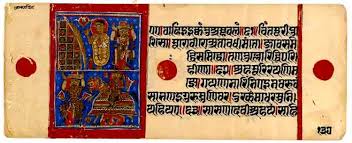
The study of ancient Indian history presents unique challenges. Unlike the Greco-Roman world, ancient India lacks secular historical narratives comparable to those of Herodotus or Thucydides. Instead, historians rely on a diverse array of sources, including archaeological findings, inscriptions, numismatics, and most importantly, religious literature. Among these religious traditions, Jainism provides a particularly valuable corpus of literature that, while primarily focused on spiritual and philosophical tenets, offers crucial insights for reconstructing the political, social, and economic landscape of ancient India. The immense value of Jain Literature lies in its potential to corroborate, complement, and sometimes even challenge information derived from other sources, leading to a more nuanced and comprehensive understanding of the past.
Jainism, with its origins dating back to at least the 6th century BCE, has maintained a continuous literary tradition spanning millennia. This extensive collection of texts, primarily written in Prakrit and Sanskrit, provides invaluable glimpses into different periods of Indian history. While the texts are imbued with religious doctrines and moral teachings, they also contain scattered, yet significant, historical details that illuminate various aspects of ancient Indian life. The challenge for historians lies in carefully extracting and analysing these historical nuggets from the predominantly spiritual context.
One of the most celebrated works in Jain literature, and a vital source for historical reconstruction, is Hemachandra's Parisistha Parvan. This 12th-century text, a hagiography of Jain teachers, is particularly renowned for its accounts of Chandragupta Maurya and his connection to Jainism. Hemachandra's narration, although filtered through the lens of religious belief, provides a compelling narrative of Chandragupta's later life, suggesting his abdication of the throne and his embrace of Jain monastic life under the guidance of Bhadrabahu. While alternative accounts exist, Parisistha Parvan offers a uniquely Jain perspective on this crucial period of Indian history, prompting scholars to re-evaluate the traditional understanding of the Mauryan empire and its potential relationship with Jainism.
Further contributing to our understanding of the Mauryan period is the traditional association of Bhadrabahu, a prominent Jain leader, with Chandragupta Maurya. While no contemporary corroboration exists to confirm this connection directly, the Jain tradition consistently identifies Bhadrabahu as the preceptor of the emperor. This consistent portrayal, even if legendary, underscores the potential influence of Jainism during the Mauryan era and highlights the need to consider the religious dimensions of the empire alongside its political and administrative achievements.
Beyond the Mauryan period, other Jain texts contribute to the broader tapestry of ancient Indian history. Katha Kosh, a collection of stories often infused with didactic messages, contains anecdotes that shed light on social customs, economic activities, and the interaction between different religious groups. Similarly, Kalika Purna, though primarily a religious text associated with the worship of the goddess Kali, occasionally offers glimpses into the political and social environment of its time, particularly with regard to the rise of new religious movements and the shifting power dynamics in different regions of India.
The Lok Vibhaga, a cosmological treatise written in 458 CE, while mainly concerned with Jain cosmology and the structure of the universe, provides valuable information about the contemporary geographical knowledge and the understanding of different regions of India and neighboring countries. The text's meticulous descriptions of geographical features and trade routes offer clues about the economic networks and cultural exchanges that shaped the ancient Indian world.
Furthermore, the core scriptures of Jainism, the Angasand Upangas, also hold historical significance, albeit more subtly. These texts, compiled over centuries, contain numerous references to contemporary social structures, economic practices, and political events. Although primarily concerned with religious doctrines and monastic rules, these references, when carefully analysed, can provide valuable insights into the daily lives of people in ancient India, their beliefs, and their interactions with the surrounding world. For instance, the texts often mention different professions, social classes, and forms of exchange, providing a glimpse into the economic organization of ancient Indian society.
The significance of Jain literature lies not merely in the isolated historical facts it provides but also in the unique perspective it offers. As a tradition often challenging the dominant Vedic Brahmanical order, Jain texts offer alternative viewpoints on social hierarchies, ritual practices, and the role of the individual in society. This alternative perspective is invaluable for understanding the complexities of ancient Indian society and for avoiding a biased or monolithic interpretation of the past.
However, utilizing Jain literature for historical reconstruction demands a critical and nuanced approach. Historians must be mindful of the religious context in which these texts were written, recognizing that the authors' primary aim was to propagate religious teachings rather than to document historical events objectively. The presence of mythical elements, exaggerations, and moralizing narratives requires careful scrutiny and cross-referencing with other sources. Furthermore, the dating of Jain texts can be challenging, requiring linguistic analysis, paleographic studies, and contextual considerations to establish their relative chronology.
In conclusion, while lacking secular historical narratives, ancient India possesses a rich and diverse literary tradition, including the valuable corpus of Jain literature. Texts like Parisistha Parvan, Katha Kosh, Kalika Purna, and the Angas and Upangas offer vital clues for reconstructing the political, social, and economic history of the subcontinent. By critically analysing these texts and integrating them with other sources, historians can gain a more nuanced and comprehensive understanding of ancient India, shedding light on the complex and dynamic processes that shaped its past. The reconstruction of Ancient India would be significantly incomplete without acknowledging and utilizing the invaluable resource that is Jain literature.